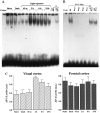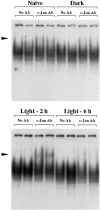Visual stimulation regulates the expression of transcription factors and modulates the composition of AP-1 in visual cortex
- PMID: 8656291
- PMCID: PMC6578611
- DOI: 10.1523/JNEUROSCI.16-12-03968.1996
Visual stimulation regulates the expression of transcription factors and modulates the composition of AP-1 in visual cortex
Abstract
It is believed that long-term changes in neuronal function are orchestrated by transcription factors, such as AP-1 and ZIF 268, which are in turn regulated by synaptic stimulation. To further our understanding of the functional effects of such expression, we have examined the DNA-binding activities of both AP-1 and ZIF 268 by way of electrophoretic mobility shift assays (EMSA) on nuclear extracts from visual cortices of rats treated with selective light exposure. Visual stimulation after dark rearing increased the DNA-binding activities of both AP-1 and ZIF 268 to their highest levels within 2 hr. ZIF 268 thereafter dropped to levels similar to that observed in naive animals, whereas AP-1 DNA-binding activity continued to remain elevated even after 24 hr of stimulation. The components of the AP-1 complex, when assessed by EMSA-supershift analysis, showed considerable variability under different conditions of exposure. FosB and JunD were the major constituents of AP-1 in both naive and dark-reared animals. Brief visual stimulation (2 hr) added c-Fos, c-Jun, and JunB to this complex, whereas prolonged stimulation (6-24 hr) reduced c-Fos and c-Jun levels significantly, leaving only FosB, JunB, and JunD as the major components of AP-1. These results suggest that transcriptional control by AP-1 may be generated by selective combinatorial interactions of different members of the Fos and Jun families and that are guided by activity-dependent processes.
Figures








Similar articles
-
Basal expression of the inducible transcription factors c-Jun, JunB, JunD, c-Fos, FosB, and Krox-24 in the adult rat brain.J Comp Neurol. 1995 Mar 27;354(1):39-56. doi: 10.1002/cne.903540105. J Comp Neurol. 1995. PMID: 7615874
-
Occupancy and composition of proteins bound to the AP-1 sites in the glucocorticoid receptor and c-jun promoters after glucocorticoid treatment and in different cell types.Recept Signal Transduct. 1996;6(3-4):179-93. Recept Signal Transduct. 1996. PMID: 9259052
-
Light-induced variations in AP-1 binding activity and composition in the rat suprachiasmatic nucleus.J Neurochem. 1999 Feb;72(2):841-7. doi: 10.1046/j.1471-4159.1999.0720841.x. J Neurochem. 1999. PMID: 9930761
-
Neuronal expression of AP-1 proteins in excitotoxic-neurodegenerative disorders and following nerve fiber lesions.Prog Neurobiol. 1995 Nov-Dec;47(4-5):257-90. Prog Neurobiol. 1995. PMID: 26445738 Review.
-
Sensory regulation of immediate-early gene expression in mammalian visual cortex: implications for functional mapping and neural plasticity.Brain Res Brain Res Rev. 1997 Apr;23(3):237-56. doi: 10.1016/s0165-0173(97)00005-2. Brain Res Brain Res Rev. 1997. PMID: 9164673 Review.
Cited by
-
Dual activity maps in primate visual cortex produced by different temporal patterns of zif268 mRNA and protein expression.Proc Natl Acad Sci U S A. 1997 Mar 18;94(6):2671-5. doi: 10.1073/pnas.94.6.2671. Proc Natl Acad Sci U S A. 1997. PMID: 9122254 Free PMC article.
-
Novel environment exposure drives temporally defined and region-specific chromatin accessibility and gene expression changes in the hippocampus.Nat Commun. 2025 Aug 21;16(1):7787. doi: 10.1038/s41467-025-63029-6. Nat Commun. 2025. PMID: 40841540 Free PMC article.
-
Identification of the Neural Correlates Underlying Conflict Resolution Performance Using a Rodent Analogue of the Stroop Tests.Neuroscience. 2023 Aug 1;524:79-88. doi: 10.1016/j.neuroscience.2023.05.024. Epub 2023 Jun 7. Neuroscience. 2023. PMID: 37290682 Free PMC article.
-
Causal role for sleep-dependent reactivation of learning-activated sensory ensembles for fear memory consolidation.Nat Commun. 2021 Feb 22;12(1):1200. doi: 10.1038/s41467-021-21471-2. Nat Commun. 2021. PMID: 33619256 Free PMC article.
-
Stress-induced c-fos expression in the medial prefrontal cortex differentially affects the main residing cell phenotypes.Heliyon. 2024 Oct 12;10(20):e39325. doi: 10.1016/j.heliyon.2024.e39325. eCollection 2024 Oct 30. Heliyon. 2024. PMID: 39498004 Free PMC article.
References
-
- Angel P, Karin M. The role of Jun, Fos and the AP-1 complex in cell-proliferation and transformation. Biochim Biophys Acta. 1991;1072:129–157. - PubMed
-
- Beaver CJ, Mitchell DE, Robertson HA. An immunohistochemical study of the rapid pattern of expression of c-Fos protein in the visual cortex of dark-reared kittens following initial exposure to light. J Comp Neurol. 1993;333:469–484. - PubMed
-
- Benson DL, Huntsman MM, Jones EG. Activity dependent changes in GAD and preprotachykinin mRNAs in visual cortex of adult monkeys. Cereb Cortex. 1994;4:40–51. - PubMed
Publication types
MeSH terms
Substances
LinkOut - more resources
Full Text Sources
Miscellaneous
